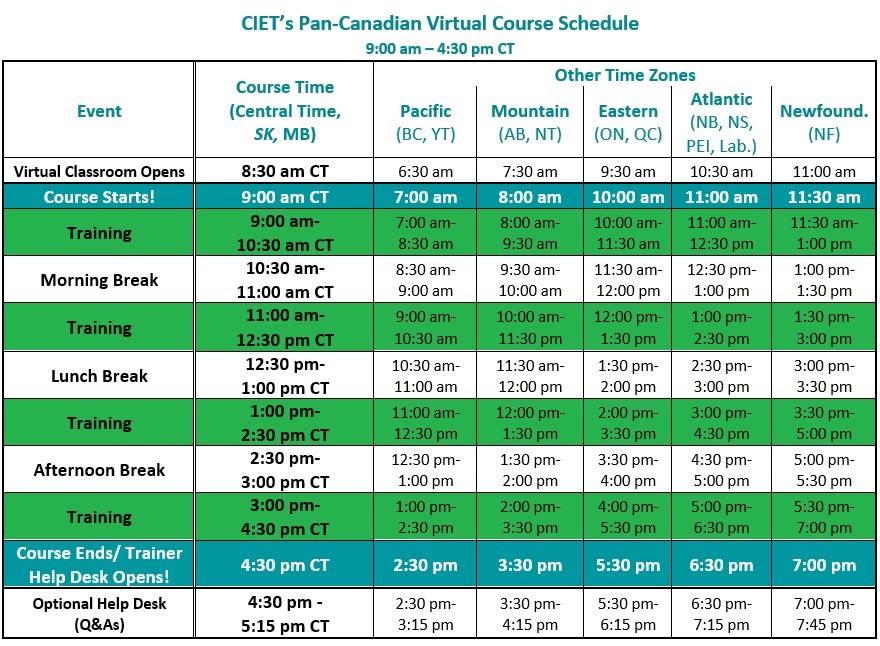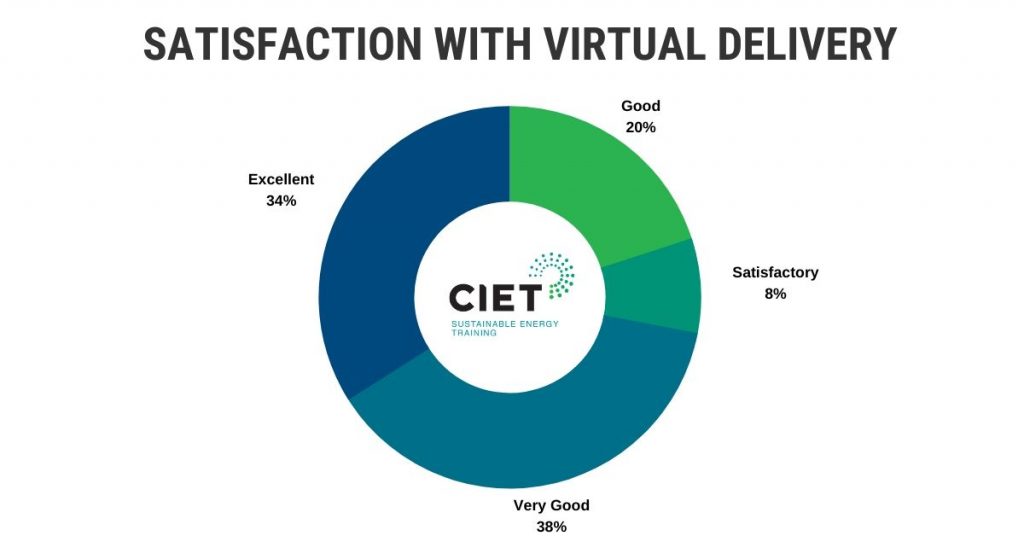
|
When I wrote Part 1 of this case study series on LinkedIn on April 1, 2020, it was no April Fool's joke; only two weeks after Canada had been hit by the COVID-19 pandemic, things were already looking up for CIET.
Since our very first virtual three-day Certified RETScreen® Expert (CRE) was delivered in mid-March, A LOT has happened here at CIET. Thanks to great work from our team, the support of our partners, and fantastic responses from participants, we have successfully delivered close to 100 days of energy efficiency training through virtual real-time classrooms. Including sessions that have run concurrently, this represents around 100 days of training in just over 70 business days!
-Mathieu Côte Executive Director
|

Undoubtedly, delivering that many courses was bound to lead to a few challenges. We have learned a lot through these challenges, and our participants, trainers and clients have been very understanding and helpful. The anecdotes and lessons learned below are intended to help organizations that deliver virtual services avoid certain issues.
My main concern with delivering training virtually was technological. We can obviously control only a fraction of the huge infrastructure required to deliver virtual training. Between our trainers’ computers, our administrative staff’s computers, GoToTraining servers, dozens of internet service providers, our participants’ internet connections, and - the weakest link of all - home Wi-Fi networks, it seemed to me that just about anything could go wrong at any time. In the end, it appears that these concerns were unfounded. Through our sustained level of training activity and usage of GoToTraining, we have faced arduous technological problems only once, on June 2. We had two courses going on that day: a one-day Existing Building Commissioning Essentials held in collaboration with BOMA NS, BOMA NB/P.E.I, and BOMA NFL; and another three-day Certified RETScreen® Expert (CRE). Our creative thinking and our team’s nimbleness were put to the test when some participants in both courses could no longer hear the course. Quickly, we asked these participants and our trainers to dial into two separate CIET teleconference lines in order to ensure that they could keep following the slides in GoToTraining online while having the audio through the conference line. This worked out okay. However, a few hours later, everyone was left without audio in the CRE course. At least this coincided with the lunch break! so we quickly created a new training session, but this time in GoToMeeting, where audio seemed to work. All participants were informed and everyone connected to the new platform right after lunch.
Offering our training courses virtually means that we no longer have to favor certain cities (like Toronto!) to the detriment of others. Now, all our courses are available to all Canadians and, sometimes, to people in other countries too. Countless participants have told us that they were very happy, probably even more so under the current confinement circumstances, to NOT have to go to a training venue for the course. This means more time with family, less time in transit, and a lot more flexibility as to what you do during breaks.
We have tried several scheduling combinations and have finally settled on the one below, with training starting at 7 am Pacific Time and ending at 7 pm Newfoundland Time. We have three 30-min breaks so that almost everyone can have a decent number of break times to prepare meals for stay-at-home kids!

Based on CIET’s close to 30 years of experience delivering energy efficiency training, and my own experience as Executive Director of CIET for eight years now, I believe that the three main things participants look for in a training course are:
1. Acquiring knowledge & skills that apply to their jobs
2. Meeting and networking with fellow professionals
3. Having a good time
The importance that you attach to each item can certainly vary a lot, but I assume that learning something useful is always #1. On that front, our virtual real-time classrooms deliver and provide at a minimum the same amount of learning, and sometimes more than our in-person courses. Indeed, we have had the opportunity to host guest trainers for short presentations, present live demos using equipment that would be bulky to transport, use computer-based exercises more effectively than in-person, as well as provide updates, modifications and reference documents on-the-go and more easily too.
The networking component of training is very important to us at CIET, and to me personally. We often say that our trainers are facilitators, there to ensure that participants learn as much from their peers as from the trainers, as other trainees collectively possess a wealth of knowledge and experience to share.. Surprisingly enough, that facilitation method has proven very effective virtually, with all participants being able to provide bits of information, answers, links and other thoughts quickly in the chat while the trainer provides the best possible answers to a lot of great questions.
However, real networking where you meet and informally chat with others before the course, during breaks or over lunch is much harder to replicate virtually. People tend to walk away from their computer during breaks to take care of their family, or binge-respond to work emails. To that effect, we have put in place a few minor but appreciated ideas:

Through every measure we put in place, we try to make sure people enjoy themselves in our virtual real-time classrooms. One surprising and very positive novelty that virtual training has afforded us is to chance be much closer to participants. Indeed, CIET staff are present and welcome participants at ALL our training sessions, creating a closer connection than ever before. We have been able to virtually meet incredibly motivated, positive, and talented energy practitioners, and I thank each and every one of our 400+ virtual participants to date. In the end, what really counts for us is whether they have added new knowledge and skills to their toolbox, passed their certification exam, and enjoyed the course. Seventy-two percent of participants said their satisfaction with the virtual delivery was either “Excellent” or “Very Good”. This is a very good start- but we will not settle for this and have already put in place several measures to improve our fall courses.

With close to 25 virtual real-time courses offered since the beginning of the COVID-19 crisis under our belt, and based on feedback received from more than 400 participants, CIET already decided several weeks ago that the Fall 2020 public training sessions will all be delivered through virtual real-time classrooms. This will: (1) allow everyone to continue accessing CIET training in a safe manner, which protects both our participants and our trainers regardless of what happens in the fall; (2) make available our training sessions to all Canadians, regardless of geographic location (or confinement status!); and (3) allow us to concentrate all our efforts on a de-risked plan. We are taking that third point very seriously and have thus already developed a multi-item plan to improve our virtual model for the fall. The plan includes:
In conclusion, I would like to sincerely thank our, participants, clients and partners, trainers and our CIET team for their wonderful support in navigating this crisis. I am very proud of the work we have accomplished and hope it is only the beginning of a new era for CIET as both the largest in-person AND virtual energy efficiency training center in Canada.
I wish you all a fantastic, yet likely different, summer.
Mathieu Côte

|
Training calendar |

Would you like to be trained on a specific topic? Just let us know!
Express my interestSend us an email and we will respond as soon as possible.

This is to inform you that the course date is too close to be able to ship hard copies of the material to you on time. If you are willing to use the material in secured PDF, receive the material later (likely after the course) and pay upon registration, please click OK to continue the registration process. Please note that the shipping process will start only when the course fees are paid in full and delays are to be expected. Many thanks!